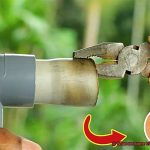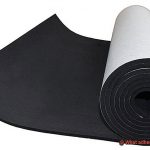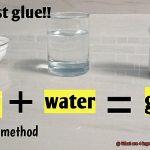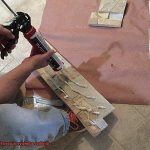Struggling with those stubborn remnants of stickers, decals, or labels that just won’t let go? We’ve all been there, feeling the frustration of battling glue that clings on for dear life. But fear not. Today, we’re about to unveil a treasure trove of unbelievable hacks that will make those glue stains vanish into thin air.
Imagine effortlessly removing glue without leaving any residue or damaging your precious surfaces. Whether it’s glass, wood, fabric, or plastic, we’ve got your back with a range of ingenious methods that will leave you wondering why you didn’t discover them sooner. Say goodbye to sticky situations once and for all.
Main Points:
- The Oily Wonder: Prepare to be amazed by the everyday kitchen oils like olive, coconut, or vegetable oil that work like magic solvents, dissolving and removing glue from any surface you can imagine.
- Vinegar for Victory: Get ready to uncover the secret power of this beloved household ingredient’s acidity as it neutralizes glue and leaves your surfaces sparkling clean.
- Sweet Citrus Solution: Harnessing the natural strength of citrus fruits like lemons and oranges, we’ll show you how their acidic properties break down adhesives while infusing a refreshing scent into your cleaning routine.
- The Power of Heat: Brace yourself for the transformative effects of applying heat – whether it’s using a blow dryer or warm water – as it loosens and removes even the most stubborn glue with ease.
- Miracle Mayonnaise: Yes, you read it right. Prepare to be astonished by mayonnaise’s unexpected ability to remove glue. It’s not just a condiment anymore.
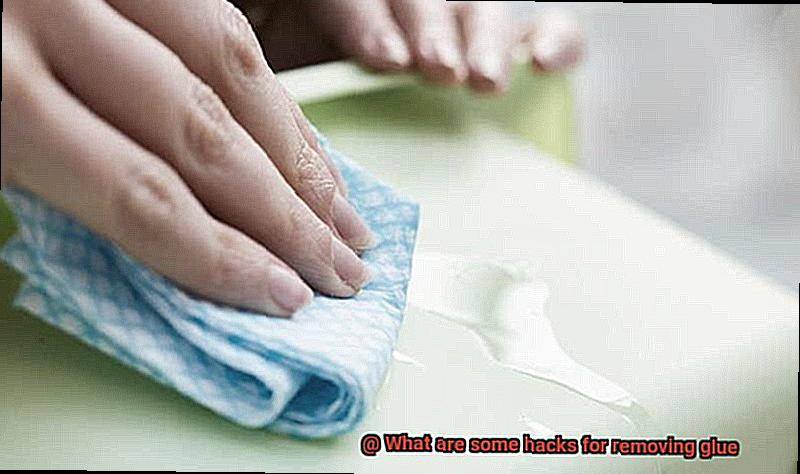
By now, you must be itching to try out these incredible hacks and liberate your belongings from the clutches of sticky glue forever. Say goodbye to unsightly residue and hours spent scraping away adhesive remnants. With these mind-blowing glue-removal hacks, tackling sticky situations becomes a breeze.
So why let glue haunt your cherished possessions any longer when these simple household items can be your saviors? Unleash the power of oils, heat, citrus, vinegar, and even mayonnaise, and say hello to a world that’s free from stubborn adhesive atrocities. Get ready to witness the magic as we delve into each hack in detail.
Acetone: The Most Effective Glue Remover
Contents
- 1 Acetone: The Most Effective Glue Remover
- 2 Rubbing Alcohol: A Common Household Item for Glue Removal
- 3 Vinegar: An Acidic Solution for Loosening Adhesive Bonds
- 4 Olive Oil: A Natural Solution for Removing Glue
- 5 Warm Soapy Water: An Easy Way to Remove Less Stubborn Glues
- 6 Heat: Softening the Glue with Heat
- 7 Other Tips and Tricks for Removing Glue
- 8 Safety Considerations When Using Chemical Solutions
When it comes to removing stubborn glue stains, look no further than acetone. This colorless liquid with a strong, pungent odor is not only versatile but also incredibly powerful. It has the ability to dissolve various adhesives, making it the go-to choice for industries and households alike. In this article, we will delve into why acetone reigns supreme as the ultimate glue remover, exploring its remarkable properties, proper usage, and safety precautions.
Breaking Down Chemical Bonds:
Acetone’s secret weapon lies in its impressive ability to break down the chemical bonds that hold adhesive molecules together. By dissolving these bonds, acetone effortlessly tackles even the toughest glues, allowing for easy removal without causing harm to surfaces. Whether you’re dealing with stubborn super glue or tenacious epoxy, acetone has got you covered.
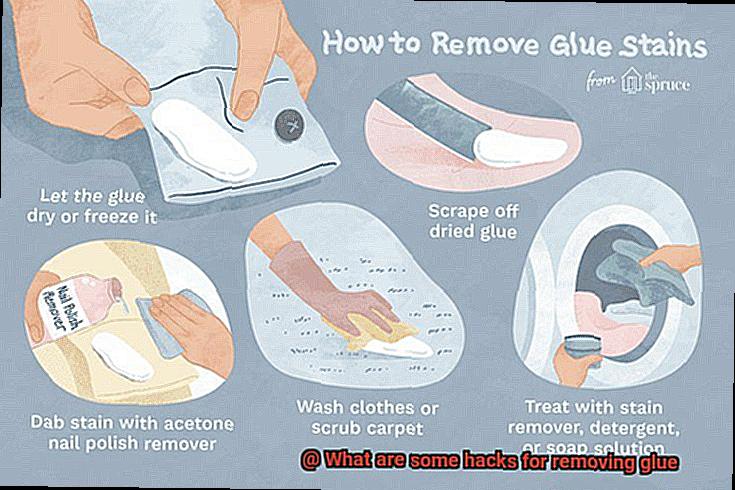
Versatility and Convenience:
What sets acetone apart from other glue removers is its unparalleled versatility. Not only can it effectively eliminate adhesive residue left behind by stickers or labels, but it can also restore surfaces to their original condition. Acetone is conveniently available in most drugstores and can even be found in everyday household products like nail polish remover.
Safety Precautions:
While acetone is undoubtedly a powerful solvent, it demands respect and careful handling. Due to its highly flammable nature, it should always be used in a well-ventilated area. Direct contact with skin or eyes must be avoided at all costs, and it should be kept out of reach of children and pets. To ensure compatibility with surfaces, it’s advisable to perform a small patch test before applying acetone on a larger scale.
Proper Usage:
To harness the full potential of acetone as a glue remover, begin by saturating a clean cloth or cotton ball with this potent solvent. Gently rub the soaked material over the glued area, allowing the acetone to penetrate deeply. For more stubborn or aged glue stains, multiple applications may be necessary. Remember to thoroughly rinse the treated area with mild soap and water to remove any residue, restoring surfaces to their former glory.
Rubbing Alcohol: A Common Household Item for Glue Removal
Imagine the frustration of trying to remove stubborn glue residue left behind by stickers and labels. But fear not, my fellow glue warriors, for I bring you a solution hidden in plain sight – rubbing alcohol.
This common household item is a versatile superhero that can effectively tackle glue removal on various surfaces. So grab your cape and let’s explore the world of rubbing alcohol and its mystical powers.
The Power of Isopropyl Alcohol:
Harnessing the might of isopropyl alcohol, rubbing alcohol becomes a formidable foe against glue. Acting as a solvent, it effortlessly breaks down the adhesive properties of glue, liberating your surfaces from sticky bonds. But how does one unleash this power?
Application Techniques:
Prepare for battle by arming yourself with a clean cloth or cotton ball. Apply a small amount of rubbing alcohol and gently dab the affected area where the stubborn glue residue persists. Allow the magic elixir to seep into the glue, preparing it for defeat.
Now, let the enchantment commence – with gentle circular motions and light pressure, watch as the rubbing alcohol dissolves the glue, making it easier to vanquish. For those larger or more resilient patches of glue residue, introduce a soft-bristled brush as your trusty sidekick. Together, you’ll agitate and loosen the adhesive’s grip without causing harm to delicate surfaces.
Glass Surfaces: Rubbing Alcohol’s Best Friend:
When it comes to glass surfaces, rubbing alcohol proves to be an unparalleled ally. Its swift-drying nature ensures minimal residue remains behind. Simply apply a dose of rubbing alcohol onto a cloth or paper towel, and with gentle strokes, witness the glue surrender its hold. Repeat this ritual if necessary, and marvel at your gloriously glue-free glass surface.
Cautionary Notes:
Though rubbing alcohol possesses great power, caution must be exercised. Its potency may cause damage or discoloration on painted or varnished wood surfaces. Always test a small, inconspicuous area before unleashing the might of rubbing alcohol on any surface, ensuring harmony between the two.
Vinegar: An Acidic Solution for Loosening Adhesive Bonds
Prepare to witness the awe-inspiring might of vinegar, my dear readers. This unassuming kitchen companion holds a remarkable secret: it possesses the uncanny ability to break the unyielding grip of adhesive bonds. Bid farewell to your sticky struggles as we venture into the captivating realm of acidic solutions.
The Science Behind the Sorcery:
Within vinegar’s humble facade lies a powerful acidic solution renowned for its myriad household applications. Today, we unveil its true potential in dissolving adhesive bonds. Enter acetic acid, the enchanting compound that resides within vinegar’s depths. This mystical acid possesses the extraordinary power to dismantle the chemical compounds that hold glue together, rendering it vulnerable and easily removable.
Choosing the Vinegar Victor:
Not all vinegars are created equal when it comes to combating adhesive adversaries. White vinegar, with its elevated acetic acid content, reigns supreme as the go-to for this noble task. However, fret not if only apple cider vinegar graces your pantry shelves; it too can unleash its prowess upon those stubborn adhesives.
The Unveiling of the Process:
Now that we’ve selected our vinegar champion, let us embark on our quest to liberate surfaces from the clutches of glue. Behold, a step-by-step guide:
- Immerse a cloth or paper towel in vinegar, saturating it with this acidic elixir.
- Lay the drenched cloth or paper towel upon the adhesive-ridden area.
- Grant it a few moments to bask in the penetrating power of vinegar, allowing it to work its enchantment on the glue.
- With anticipation building, gently massage the area using your cloth or paper towel, coaxing the adhesive into submission.
- Should tenacious foes persist, arm yourself with a soft-bristled brush and employ gentle strokes to scrub away their resistance.
- Once the adhesive’s resolve has weakened, seize a plastic scraper or rely on your nimble fingers to triumphantly peel it away.
Olive Oil: A Natural Solution for Removing Glue
Prepare to witness the remarkable power of a kitchen hero that goes beyond culinary greatness. Behold, the extraordinary olive oil—a formidable weapon in your quest to conquer stubborn glue. From delicate glass to resilient wood, this natural elixir effortlessly dissolves glue, rendering it defenseless against your might. So, don your apron and embark on a journey into the enchanting world of olive oil, where the battle against glue is won with grace and eco-friendly prowess.
A Gentle Touch, Unleashing Strength:
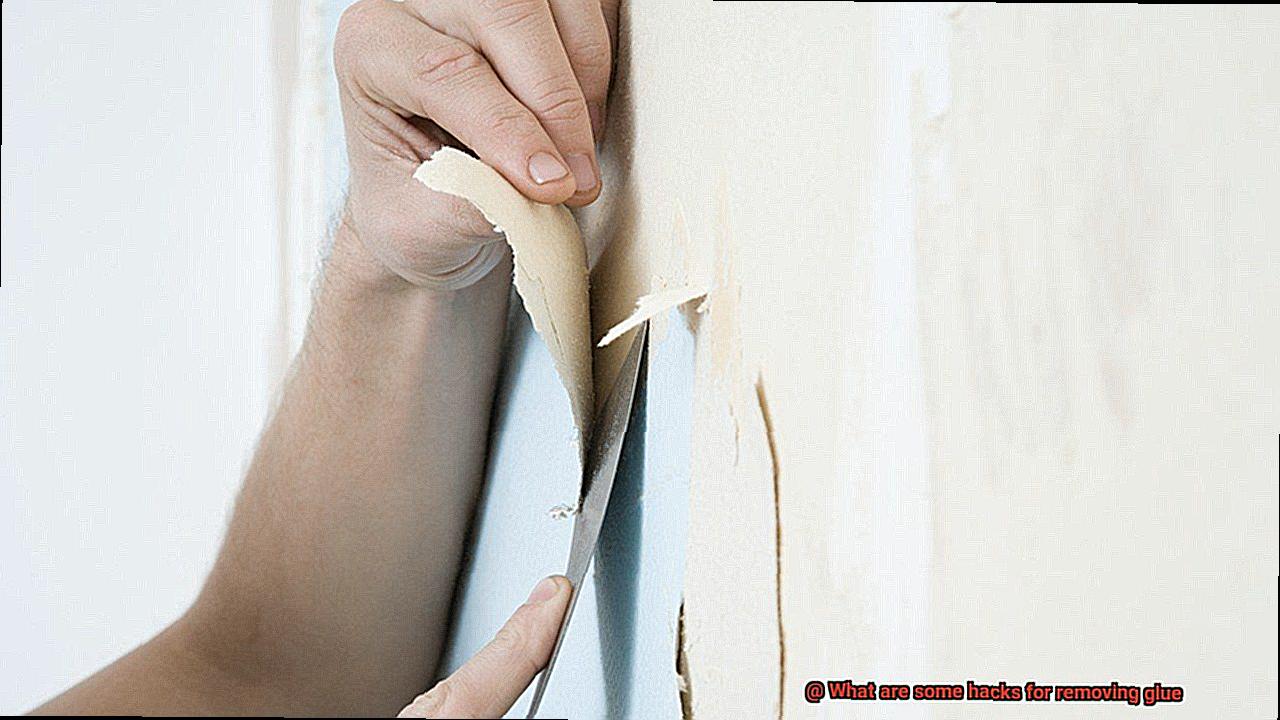
In a world full of harsh chemicals, olive oil stands as a beacon of safety and non-toxicity. Unlike its aggressive counterparts, this miraculous liquid poses no harm to delicate materials like glass, plastic, or wood. With olive oil as your ally, you can banish glue without leaving a trace—a gentle touch that packs an unparalleled punch.
An Alchemist’s Secret: Breaking Down Bonds:
Prepare to dive into the realm of science as olive oil reveals its mystical powers. With precision and finesse, it breaks down the very chemical bonds that hold glue captive. Just a small amount of oil applied to the offending area allows it to work its enchantment within minutes. Witness as olive oil becomes the master locksmith, skillfully opening the door to freedom from glue’s tenacious grip.
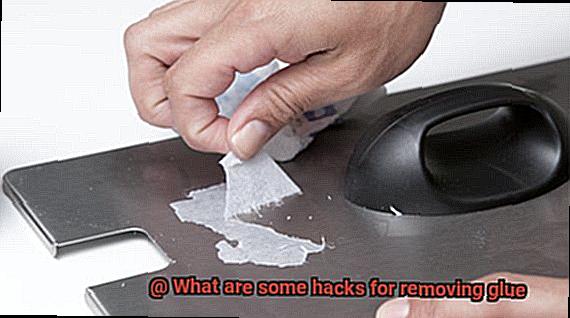
The Art of Gentle Scrubbing:
Now it’s time to put your hands to work and unleash your inner artist. Armed with cloth or sponge, you’ll gently scrub away at the remnants of glue—the last vestiges of the battle. Applying just enough pressure to loosen the adhesive without causing harm, you’ll revel in the satisfaction akin to a master masseuse kneading away tension—leaving only smoothness and victory in your wake.
Defeating Resilient Foes:
Not all battles are easily won. But fear not, for olive oil is steadfast in its commitment to vanquish even the most stubborn and dried-on glue residues. Should the need arise, repeat the process or call upon a trusty scraper to assist in your crusade. With olive oil as your unwavering ally, you’ll face each challenge head-on, ensuring not a trace of glue remains.
Warm Soapy Water: An Easy Way to Remove Less Stubborn Glues
Let me unveil a secret weapon that will make your battles against less stubborn glues a breeze. Prepare to be amazed by the enchanting powers of warm soapy water, a humble yet potent solution that dissolves adhesive magic and leaves you with pristine surfaces. Get ready to conquer those pesky glues like a true warrior.
Arm Yourself with the Essentials:
Before diving into the battlefield, gather your tools of war: a basin or bowl filled with warm water and a few drops of dish soap. This simple concoction will serve as your arsenal against the glue invasion.
Immerse and Soak:
Submerge the glued area in the warm soapy water and let it luxuriate in its transformative bath for a few minutes. Witness as the spellbinding properties of warm soapy water gradually weaken the adhesive’s stronghold.
Gentle Scrubbing, a Symphony of Liberation:
Once the soaking session is complete, unleash your scrubbing prowess. With a soft cloth or sponge in hand, gently scrub the glued area. The warm soapy water acts as a harmonious conductor, dissolving the glue’s grip and allowing it to be wiped away effortlessly. For larger surfaces, enlist the aid of a soft-bristle brush, ensuring no abrasive materials are used that could mar the surface’s beauty.
Persistence Prevails:
Never surrender. Should remnants of glue persist, do not lose heart. Repeat the soaking and scrubbing process until every last trace of adhesive has been vanquished from existence. Victory shall be yours.

The Ideal Battleground: Non-Porous Surfaces:
Warm soapy water exhibits its full might on non-porous surfaces such as glass, plastic, and metal. It fearlessly battles adhesive tapes, stickers, and labels that dare to defy your cleaning prowess. Witness the transformative power of this magical elixir.
When the Glue Proves Formidable:
Alas, even the most valiant warriors have their limits. Warm soapy water may not be as effective against more resilient foes or completely dried glues. In such dire circumstances, call upon other techniques or specialized solvents designed specifically for removing tough adhesives. Remember, adaptability is key in the war against stubborn glues.
Heat: Softening the Glue with Heat
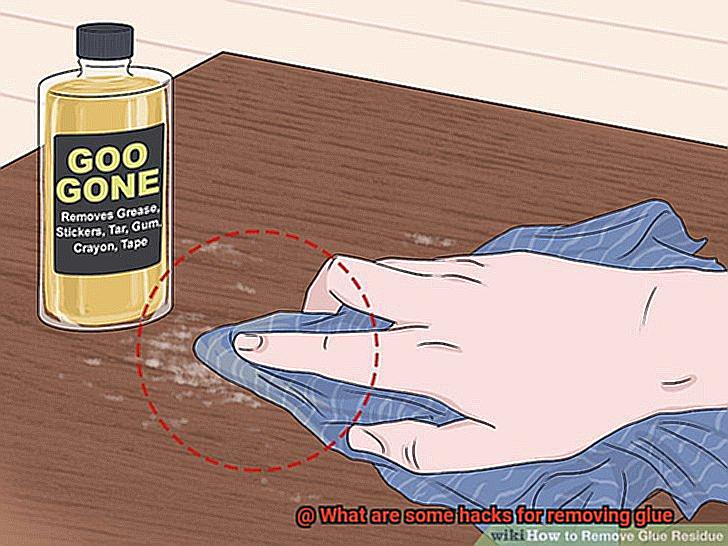
When it comes to removing stubborn glue, heat is the secret ingredient that can make the process a breeze. In this captivating exploration, we will delve into the enchanting powers of heat and how it can transform glue into a pliable wonder. So grab your hairdryers or heat guns and prepare to embark on a magical journey through the world of heat and glue removal.
Breaking Down the Bonds: Unleashing the Science
Heat works its magic by breaking down the chemical bonds that hold glue together. This mesmerizing process transforms once steadfast adhesive into a pliable substance that can be easily manipulated.
Hairdryers and Heat Guns: Trusty Allies in the Battle
For larger surfaces like glass, metal, or plastic, hairdryers or heat guns are your trusty weapons. By directing warm air onto the glued area, you can witness the glue soften before your eyes. Remember to keep the heat source in constant motion, sparing no spot for too long to protect the surface from damage.
Hot Water: A Soothing Potion for Fabrics
When dealing with fabrics or textiles, hot water becomes a soothing potion for removing glue. Soak the affected area in hot water to witness the adhesive’s grip loosen, making scraping off a breeze. Just be sure to use hot water rather than boiling water to preserve delicate materials.
Precision Tools: Mastering Delicate Glue Removal
For smaller or delicate items like jewelry or electronics, precision is key. Enter the hot air pencil or soldering iron with a small attachment. These refined tools allow for precise application of heat without risking harm to surrounding areas.
Safety First: Embarking on a Magical Adventure with Precautions
While heat holds incredible power, safety should always be at the forefront. Follow manufacturer’s instructions when using heating tools or devices. Don protective gloves and eye protection to ensure a safe glue removal experience. Remember, safety is the key to a successful magical journey.
Other Tips and Tricks for Removing Glue
When it comes to removing glue, a little creativity can go a long way. In this blog post, we’ll explore some lesser-known tips and tricks that can help you bid farewell to stubborn adhesive stains. From harnessing the power of heat to utilizing solvents and gentle cleaning techniques, we’ve got you covered.
Harness the Power of Heat:
The secret to softening stubborn glue lies in the application of heat. Grab your trusty hairdryer or heat gun (with caution.) and direct the warm air towards the glue. As the adhesive begins to melt, gently scrape it off using a flexible plastic scraper or an old credit card. Just remember not to overdo the heat, as certain materials may be sensitive to excessive temperatures.
Rubbing Alcohol or Nail Polish Remover:
For water-based glues like white glue or school glue, look no further than your medicine cabinet for the solution. Rubbing alcohol or nail polish remover contains solvents that can break down adhesives effectively. Dampen a clean cloth or cotton ball with either solution and gently rub it onto the glue. Watch in amazement as the adhesive dissolves before your eyes, allowing you to wipe it away effortlessly.
Unleash the Power of Vinegar or Lemon Juice:
For those stubborn glue stains that just won’t give up, it’s time to turn to nature’s secret weapons – vinegar and lemon juice. These acidic substances work wonders in breaking down adhesive bonds. Soak a cloth in vinegar or lemon juice and apply it directly to the glue. Allow it to sit for a few minutes, then unleash your inner scrubbing prowess with a soft brush or sponge. Rinse with water afterward to bid farewell to any residue.
Skin-Saving Solution for Super Glue Mishaps:
If you find yourself in a sticky situation with super glue on your skin, don’t panic. Soak the affected area in warm soapy water for a few minutes to soften the adhesive. Then, gently peel or roll the glue away from your skin. Avoid tugging too forcefully, as this could lead to skin irritation. For more stubborn cases, reach for acetone-based nail polish remover or an adhesive remover specifically designed for skin.
Delicate Surfaces Demand Delicate Solutions:
When dealing with fragile surfaces like glass or electronics, a gentle touch is essential. Harsh chemicals and abrasive materials are a no-go. Instead, opt for an adhesive remover specially formulated for delicate surfaces. Apply a small amount to a cloth and gently rub the glue until it dissolves. Always follow the manufacturer’s instructions to ensure optimal results.
Safety Considerations When Using Chemical Solutions
Get ready to tackle those stubborn glue stains with our secret weapons. But before you dive in and start using chemical solutions to remove glue, prioritizing safety is crucial.
In this section, we’ll explore the essential safety considerations that should be taken into account when using these powerful solutions. So grab a cup of coffee, sit back, and let’s delve into this topic together.
Read and Follow Instructions:
First and foremost, always read and follow the instructions provided by the manufacturer. These instructions contain valuable information on how to use the product safely and effectively. By following them, you’ll ensure you’re using the solution correctly, minimizing any potential risks.
Work in a Well-Ventilated Area:
Chemical solutions can release harmful fumes when used to remove glue. To prevent any respiratory issues, it’s crucial to work in a well-ventilated area. Open windows or use fans to ensure proper air circulation. Fresh air is your best friend when dealing with these strong chemicals.
Wear Personal Protective Equipment (PPE):
Protecting yourself is paramount when handling chemical solutions. Always wear appropriate personal protective equipment (PPE) such as gloves, goggles, and a mask. These items shield your skin, eyes, and respiratory system from potential exposure to harmful chemicals.
Test on a Small Area:
Before applying any chemical solution to remove glue, it’s vital to test it on a small, inconspicuous area first. This simple step will help you determine if the solution is compatible with the surface and prevent any potential damage or discoloration. Better safe than sorry.
Keep Out of Reach and Store Properly:
Ensure that chemical solutions are stored in a secure location away from children, pets, food, beverages, and other household items. Keeping them out of reach prevents any accidental ingestion or exposure. Additionally, follow local regulations and guidelines for disposing of chemical solutions, as some may require special disposal methods due to their hazardous nature.
Be Prepared for Accidents:
Even with all precautions in place, accidents can happen. If accidental ingestion or contact with eyes or skin occurs, seek medical help immediately. Keep the contact information for poison control centers readily available in case of emergencies.
2Ir8bPCtYSg” >


